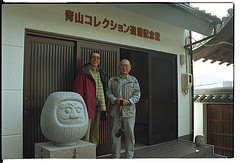:::::::::::::::::::::::::::::::::::::::::::::::::::::::::::::::::::::::::::::::::::::::::::::::::::::
senryoobako 千両箱 money box
金千両 1000 Ryo of Gold Money

Vintage wooden Japanese Daruma dolls with money boxes on a cart.
Seven Daruma are on the money boxes/cart being pulled by the eighth.
It measures 4" long x 2" deep x 2-3/4" high.
- from kyototraditions ebay
.......................................................................

source : amanaimages.com/info
寅 Lucky Daruma for the year of the Tiger
.......................................................................

福助 Fukusuke and Senryobako
.......................................................................

千両箱担狐(菱屋) Inari Fox carrying a box

狐馬引 Inari Fox leading a horse with a box

- source : d4.dion.ne.jp/~toshi-mr -
:::::::::::::::::::::::::::::::::::::::::::::::::::::::::::::::::::::::::::::::::::::::::::::::::::::

senryoobako 千両箱 Senryobako
boxes to store one thousand Ryoo of gold coins
money chest
They were the symbol of the rich (and often corrupt) merchants of Edo.
.......................................................................
江戸東京博物館 Edo Tokyo Hakubutsukan Museum


- source : 8mada.at.webry.info -
:::::::::::::::::::::::::::::::::::::::::::::::::::::::::::::::::::::::::::::::::::::::::::::::::::::

Ebisu and Daikoku leading a horse loaded with Senryobako.
The Lucky Deities visit to Enoshima
print by Utagawa Yoshiiku, 1869.
『福神江の嶋もうて』(芳幾、1869年)。
恵比寿と大黒が千両箱を背負った馬をつれて江の島を訪れる。周りには小判、江の島後景からは旭日が昇る「目出度さ」を表す構図。
- reference : wikipedia -
:::::::::::::::::::::::::::::::::::::::::::::::::::::::::::::::::::::::::::::::::::::::::::::::::::::

Utagawa Toyokuni I
The famous child Sumo wrestler lifting a Money Box.
. Daidôzan Bungorô 大童山文五郎 Sumo .
:::::::::::::::::::::::::::::::::::::::::::::::::::::::::::::::::::::::::::::::::::::::::::::::::::::
Manekineko 招き猫 with Senryobako for good luck


CLICK for more photos !
:::::::::::::::::::::::::::::::::::::::::::::::::::::::::::::::::::::::::::::::::::::::::::::::::::::
. Coins (kozeni小銭) and money in Edo
Kanemochi, a rich Daruma holding money
Yamabuki-Iro, Yellow Daruma
山吹色の黄色だるま、千両箱にだるま
.......................................................................
Kokeshi こけし <> Wooden Dolls
Kokeshi (1) こけし..... Kokeshi (2) こけし ..... Kokeshi (3) こけし

:::::::::::::::::::::::::::::::::::::::::::::::::::::::::::::::::::::::::::::::::::::::::::::::::::::
. Legends and Tales from Japan 伝説 - Introduction .
................................... Aomori 青森県
五戸町 Gonohe
なめくぢの化物 The Namekuji Slug Monster
Once there was an actor with the stage name of タヌキ Tanuki. He got a message from his mother and was on his way home to visit her. On a pass where monsters come out at night it was already evening. A namekuji slug monster came out and took him for a real Tanuki badger. The monster asked him for something that he was most afraid of, so he answered 金 Gold Money . The next evening the slug, who thought to fight him to the death, threw a box of 1000 gold coins into his home.

source : 調布 妖怪通信
namekuji yokai なめなめくじくじ / 蛞抉、slug monster
. namekujira なめくじら slugwhale Yokai .
................................... Hyogo 兵庫県
In the 氷上郡 Hikami district
The father of a well-to-do family died and had one Senryobako buried with him in the grave. The second one he gave to his adopted child. The brothers of this man got envious, shape-shifted to エンマ大王 King Enma of Hell and dug the first Senryobako out of the grave. Then they went to the home of the adopted child. This had already been killed by other relatives who gave it some ぼたもち Botamochi rice cakes with poison.
................................... Kyoto 京都府
In 三和町 Miwa
A man called サンエモン Sanemon once met a fox. The fox asked him for something that he was most afraid of, so he answered "千両箱 a Senryobako ". Soon the fox threw one at him. Saemon got it and became a rich man after that!
................................... Niigata 新潟県
吉川町 Yoshikawa
貧乏神 Binbogami - Deity of Poverty
On the second day of the New Year villagers got special wood out of the forest and offer it at the House Altar. On the 15th day it is used to cook rice gruel.
Once a poor grandfather used fresh wood for the cooking, but the Binbogami who lived in the kitchen ceiling did not like the smoke and got angry. He asked the old man: "Grandfather, what do you dislike most?"
"Well, I have no money." replied Grandfather. So the Binbogami threw three Senryobako at him and left the house for good. Since then people use old wood cut on the second day.
miji-gusa 味地草 Michigusa and nurude ヌルデ Rhus javanica (laquer tree)
- - - - - a more detailed tale is told here
正月14日に貧乏神を煙で退散させる話
(How to get rid of Binbogami on the 14th day of the New Year)

- source : nihon.syoukoukai.com/modules/stories -
. binboogami 貧乏神 God of Poverty, Bimbogami .
...................................
- reference : nichibun yokai database 妖怪データベース -
:::::::::::::::::::::::::::::::::::::::::::::::::::::::::::::::::::::::::::::::::::::::::::::::::::::
. senryoo 仙蓼 , 千両 (せんりょう)
Sarcandra glabra, Chloranthus glaber
Plant. kigo for all winter
:::::::::::::::::::::::::::::::::::::::::::::::::::::::::::::::::::::::::::::::::::::::::::::::::::::
. Welcome to Edo 江戸 Yedo ! .
[ . BACK to WORLDKIGO . TOP . ]
[ . BACK to DARUMA MUSEUM TOP . ]
:::::::::::::::::::::::::::::::::::::::::::::::::::::::::::::::::::::::::::::::::::::::::::::::::::::














































